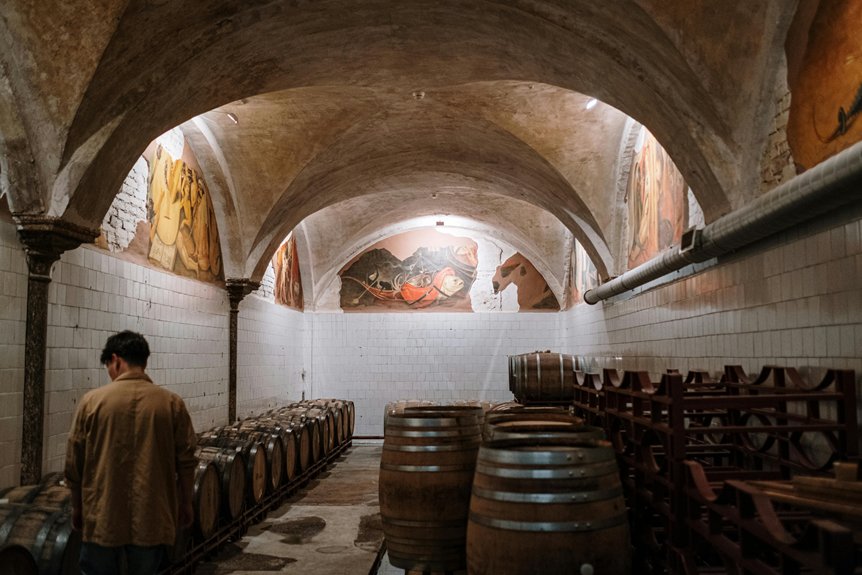You’ll discover three extraordinary features of the Enkleistra Cave: its legendary burial space that miraculously adjusts in size, Byzantine frescoes by Theodore Apsuedes crafted with rare pigments like lapis lazuli, and meticulously carved living quarters seamlessly integrating spiritual practice with architectural precision. These elements transform Saint Neophytos’ 12th-century hermitage from a simple cave into a profound spiritual landscape. Intriguing details await your exploration.
Punti di forza
- The Enkleistra Cave features a legendary grave that miraculously adjusts its size to accommodate the person lying within, symbolizing Saint Neophytos’ spiritual mystique.
- Byzantine frescoes created by Theodore Apsuedes in 1183 showcase exceptional artistic mastery using expensive pigments like lapis lazuli and gold.
- The cave is meticulously carved into the rocky Cypriot landscape, integrating living quarters, prayer spaces, and a personal burial site with remarkable architectural precision.
- Located just 150 meters from Agios Neophytos Monastery in Paphos, the cave was personally excavated by Saint Neophytos in 1159 as a hermitage.
- The site represents a profound spiritual sanctuary that demonstrates the intricate relationship between physical space, religious devotion, and medieval monastic artistic expression.
The Legendary Enkleistra Cave of Saint Neophytos
Nestled in the rugged hills of Cyprus, the Enkleistra cave stands as a witness to Saint Neophytos’ profound spiritual dedication. Located merely 150 meters from the Agios Neophytos Monastery in Paphos, this sacred space reveals the hermit’s remarkable historical and spiritual significance. In 1159, Saint Neophytos personally excavated this cave, transforming it into a hermitage cell and chapel after seeking solitude in the Cypriot landscape.
The cave’s mystique extends beyond its architectural origins. A compelling legend suggests that Saint Neophytos’ grave possesses an extraordinary characteristic: its size miraculously adjusts to accommodate whoever lies within. The interior walls showcase exceptional Byzantine frescoes from the 12th-15th centuries, representing extraordinary artistic and religious documentation.
Byzantine Frescoes: Artistic Masterpieces of the Monastery
Because Byzantine art represents a pinnacle of medieval religious expression, the frescoes within the Enkleistra of Agios Neophytos Monastery stand as an extraordinary record, evidence, or demonstration to 12th-15th century ecclesiastical artistry. The intricate wall paintings, chiefly created by Theodore Apsuedes in 1183, reveal a sophisticated artistic tradition that transcends mere decoration.
You’ll discover five distinct painting phases that illuminate the evolutionary trajectory of monastic artistic practices. The frescoes showcase remarkable technical mastery, employing expensive pigments like lapis lazuli, gold, and silver-materials that signify substantial artistic investment and cultural significance. These works meticulously depict traditional Byzantine church iconography and narrative scenes from Saint Neophytos’s life, providing scholars with profound insights into religious visual communication of the era.
Preservation efforts have been critical in maintaining these delicate, historically significant artworks, ensuring that future generations can appreciate their extraordinary aesthetic and cultural value.
Architectural Marvels of a 12th-Century Hermitage
The Byzantine frescoes’ intricate artistry leads us directly to the architectural ingenuity of the Enkleistra, a hermitage that represents more than mere physical shelter-it embodies a sophisticated architectural response to spiritual contemplation. Carved meticulously into the rocky landscape, the cave hermitage demonstrates remarkable precision in its spatial design, integrating living quarters, prayer spaces, and a burial site within a single organic structure.
You’ll observe the strategic placement of Saint Neophytos’ personal cell, which harmonizes with the natural rock formations, creating an intimate environment conducive to solitary reflection. The tomb, a central architectural element, exemplifies the mystical connection between physical space and spiritual practice. Intricate wall carvings and carefully planned spatial relationships reveal a profound understanding of architectural functionality within a monastic context.
The Enkleistra’s design transcends mere construction, representing a sophisticated architectural manifestation of eremitic devotion and contemplative practice.
Domande frequenti
How Do Visitors Access the Monastery Located on a Steep Rock Face?
You’ll access the Agios Neophytos Monastery via a carefully constructed pathway that navigates the steep rocky terrain. The approach requires moderate physical fitness, as you’ll traverse narrow, carefully maintained stone steps and walking trails. These strategically designed routes allow you to ascend the rock face safely, providing intermittent panoramic views of the surrounding landscape. Your journey involves careful navigation and appreciation of the monastery’s remarkable architectural integration with the natural environment.
Can Tourists Touch or Closely Examine the Original Byzantine Wall Paintings?
Like a fragile tapestry of faith, the Byzantine wall paintings demand delicate handling. You’ll find that direct physical contact is strictly prohibited to preserve these ancient masterpieces. Guided tours allow you to observe the intricate frescoes from a carefully maintained distance, protecting the paintings’ pigments and structural integrity. Trained conservators meticulously monitor the artwork’s condition, ensuring these remarkable 12th-century religious representations remain intact for future scholarly examination and appreciation.
Are Guided Tours Available to Explain the Monastery’s Historical Significance?
You’ll find guided tours are indeed available at the Agios Neophytos Monastery, offering scholarly insights into its rich Byzantine heritage. Knowledgeable local guides systematically interpret the site’s historical trajectories, architectural nuances, and cultural significance. They’ll methodically explain the monastery’s foundational narrative, detailing the hermit monk Neophytos’ pivotal role, and illuminate the intricate wall paintings’ theological and artistic contexts with academic precision.
What Are the Operating Hours and Admission Fees for the Monastery?
If you’re Googling monastery visit times, you’ll find Agios Neophytos operates daily from 9:00 AM to 4:00 PM. Admission fees are modest: adults pay approximately €5, while students and seniors receive discounted rates around €3. You’ll want to bring cash, as digital payment options might be limited. The monastery’s operating schedule can slightly vary during religious holidays, so it’s prudent to verify current hours before your planned excursion.
Is Photography Permitted Inside the Monastery’s Church and Museum Areas?
Photography policies at the Agios Neophytos Monastery are typically restrictive. You’ll likely find that interior photography of the church and museum is prohibited, particularly during religious services or in sensitive artifact areas. While exterior shots are generally permitted, you should always seek explicit permission from monastery staff before capturing images. Respectful visitor conduct and cultural preservation guidelines typically govern these photographic restrictions.
Conclusione
You’ll find the Agios Neophytos Monastery’s cave a profound __________ to Byzantine spiritual and artistic heritage. Consider a pilgrim like Maria, who traveled from Athens, experiencing the intricate frescoes and understanding how this hermitage represents more than a historical site-it’s a living narrative of medieval Cyprus’s cultural resilience. Its preserved artistry and architectural significance continue to illuminate medieval monastic traditions.

Vi presentiamo Natalie, che vive a Cipro da 10 anni. Ama esplorare la splendida natura dell'isola, come le foreste silenziose e le spiagge incontaminate. Natalie ha molte esperienze interessanti da condividere. Scoprite con lei le sue avventure a Cipro.

